


Sign-up for {N}power to get exclusive discounts, newsletters, members-only features, and more!

All over the world, mushrooms are beloved, treasured, and integrated into daily life for their incredible health benefits. Now is a great time to reap the rewards that mushroom supplements hold, to make your health goals all the more achievable. Let’s dig into each well-researched mushroom as we forage for knowledge and harvest good health; these mushrooms are here to help in an exciting array of health-supporting ways.
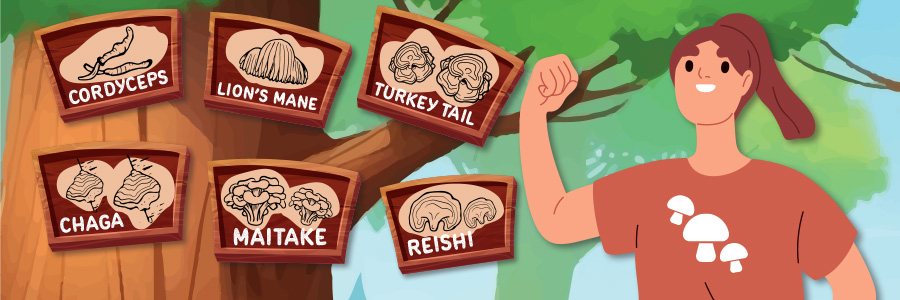
With the sheer number of mushrooms available these days, it may feel overwhelming to know which ones are right for you and your specific health goals. This is one of the things that makes mushrooms such an exciting area of research—while many of their health-promoting properties overlap, each one has unique ways of supporting health. Find the mushrooms best for you by trying different ones suited to your health goals and needs; sometimes that means one particular type, but it also may mean mixing and matching different varieties. Have fun exploring the health benefits mushrooms can bring to you!
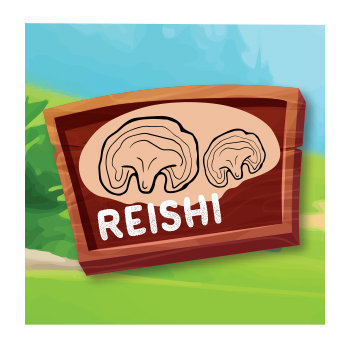
Reishi, also known as the Queen of Mushrooms, contains hundreds of different bioactive compounds that exhibit antioxidant, anti-inflammatory, anti-tumor, and immuno-stimulating activity. It has been used as a medicinal mushroom for more than 2,000 years, and in Traditional Chinese Medicine (TCM) it is used to replenish and strengthen Qi, or “life force,” to calm the mind, and to treat respiratory conditions and insomnia.1 Even today, reishi is approved by China’s equivalent of the FDA to treat insomnia, chronic hepatitis, chronic bronchitis, and coronary heart disease.2 Western science has largely focused on its role in immunity and cancer, with promising results. In addition, scientists are zeroing in on its potential as an anti-aging and longevity super nutrient.
Several studies have found that reishi—including the fruiting body and the mycelium—contain polysaccharides that can enhance immune function and activate the immune response. Research has shown that the polysaccharides in reishi are potent immunomodulators that exert “a significant and comprehensive impact on immune cells…” Reishi polysaccharides have also been shown to exhibit antiviral and antibacterial actions.3 4
In China, reishi is used as a standard treatment for insomnia, and animal research has demonstrated that the fruiting body of reishi significantly increases total sleep time and non-rapid eye movement (NREM) sleep, or deep sleep.5 In other research, a well-controlled human trial found that an extract of reishi was an effective treatment for “neurasthenia,” a medical condition characterized by physical and mental exhaustion, accompanied by headache, irritability, and sleep disturbance (in other words, a typical stress response). Eight weeks of supplementing with a reishi extract at 1,800 mg three times daily resulted in a significant improvement in symptoms, including fatigue and an overall sense of wellbeing.6
Research has also found that reishi has a positive effect on liver health. A 2017 study showed that taking a reishi supplement daily for six months (225 mg/daily) significantly improved the body’s antioxidant status, lowered markers of oxidative stress, and had a liver-protective effect among healthy adults aged 40–45 who had mild liver dysfunction and fatty liver.7

This puffy white mushroom that resembles a lion’s mane has been used as both food and medicine in East Asian countries for centuries, but today it has become synonymous with brain and nerve health.8 Both the mycelium (a mushroom’s equivalent of roots) and the fruiting body (the mushroom) have been found to have neuroprotective, nootropic (cognitive supporting), and mood-enhancing effects. And new research in young adults is helping solidify lion’s mane as “the brain’s best friend.”
In a 2023 double-blind, placebo-controlled, randomized trial studying the effects of lion’s mane supplementation on cognition, stress, and mood in participants ages 18–45, the subjects took three capsules of a placebo or 600 mg of lion’s mane per day for 28 days. The lion’s mane group saw a significant improvement in reaction time scores, processing speed, and focus compared to the placebo group. The self-reported stress scores in the mushroom group also significantly improved after 28 days compared to the placebo group.9
Additional research on lion’s mane has also emerged in women with perimenopausal symptoms, including mood and sleep disturbances. In one study, middle-aged women ate cookies containing 500 mg of powdered lion’s mane (fruiting body) or placebo cookies for four weeks and were instructed to eat four cookies daily (totaling 2,000 mg lion’s mane powder). At the end of just four weeks, the participants who ate the lion’s mane cookies reported a significant reduction in depression. Researchers conclude that lion’s mane may work to improve mood by supporting the autonomic nervous system and hormonal balance.10
One of lion mane’s most unique properties is its ability to increase nerve growth factor (NGF) and brain-derived neurotrophic factor (BDNF). NGF and BDNF are specialized proteins that play important roles in neuronal growth and health, allow neurons to communicate, and support neuronal plasticity, which is essential for learning and memory. Lion’s mane has also been shown to stimulate the production of myelin, the protective covering around nerves that allows nerve signals to be sent and received quickly and efficiently. Damaged myelin underlies some neurodegenerative diseases like Alzheimer’s and multiple sclerosis. Finally, lion’s mane has been found to promote nerve regeneration and functional recovery after severe nerve injury.11 12 13 14 15
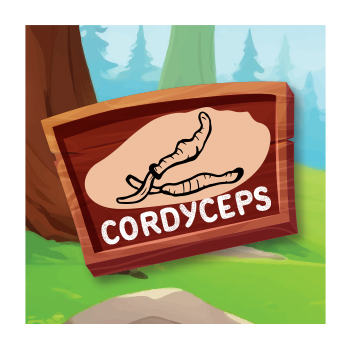
This parasitic fungus is found at very high altitudes (12,000+ feet) and grows from the bodies of caterpillars, which it mummifies as it grows. It has long been valued in Chinese and Tibetan medicine, with some traditional healers in the Himalayas recommending it for all illnesses, claiming that cordyceps improves energy, stamina, libido, and endurance and promotes longevity. It has been used traditionally to treat asthma, bronchitis, diabetes, erectile dysfunction, liver disease, and cancer.16 Modern research has investigated some of these claims and as one scientific review of the biological and pharmacological properties of cordyceps states, “Scientific proof of the effects of the Cordyceps mushroom seems to be quite promising and coincide with the folk practices of … parts of India, China, Nepal, and Bhutan.”17
In modern times, cordyceps is used in China to restore health after illness and speed recovery from exhaustion. One animal study found that an extract of the mycelium significantly increased the swimming time of mice by activating metabolic regulators, including AMPK, an enzyme known as a metabolic “master switch” that regulates how energy is produced and used in the body; activation of AMPK increases glucose uptake, fat burning, and mitochondrial biogenesis. The researchers concluded that cordyceps “can be used as a potent natural exercise mimetic” (i.e., imitator).18 Human research has shown that long-term supplementation with cordyceps (studies have used between one and four grams daily for at least three weeks) enhances blood flow and oxygen utilization and decreases time to exhaustion during high-intensity and aerobic exercise.19
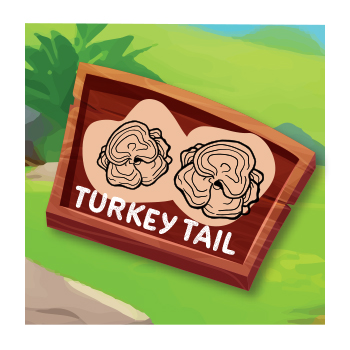
Turkey tail is most well-known for its ability to support the gut microbiome and the immune system. Specifically, it serves as a prebiotic food for our beneficial gut bugs, supporting a healthy gut microbiome (when we have a healthy gut microbiome, this translates to whole body health).20 It also supports an engaged and balanced immune response, meaning it invigorates immune cells while simultaneously making sure the immune system doesn’t overreact. And while all mushrooms support immunity, turkey tail is the master.
What sets turkey tail apart from the rest are two unique beta-glucans: polysaccharide krestin (PSK) and polysaccharide peptide (PSP), which have both been shown to be beneficial for supporting a healthy immune system in human clinical research, particularly in those with cancer.21
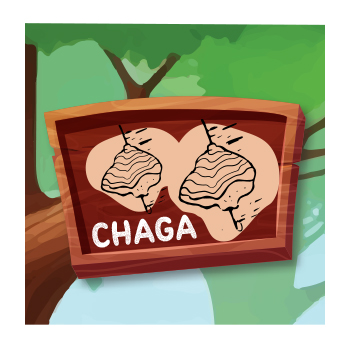
This fungal species has a long history of use in Russia and Siberia. It is unique in the mushroom world in that it manifests not as the fruiting body of the fungus, but as a mass of mycelium. It has been used as a folk remedy for inflammatory digestive disorders, such as ulcers and gastritis, and as an antiparasitic and antiseptic; in modern times, it is revered for its antibacterial, antiviral, anti-inflammatory, antioxidant, and anti-tumor properties.22 Chaga is one of the single richest sources of antioxidants found in nature, far surpassing other antioxidant-rich foods like raw cocoa powder, dark chocolate, blueberries, and spinach.
Chaga extract has a history of use in Soviet Russia as a treatment for chronic gastritis and gastric ulcers, and when used in conjunction with traditional therapy for gastric ulcers, was reported to reduce hospital stays and double the length of remission.23 In more recent research, scientists found that an alcohol extract of chaga reduced oxidative damage to white blood cells by 54.9 percent in patients with inflammatory bowel disease, including Crohn’s and ulcerative colitis,24 and an animal model of colitis found that a water extract of chaga significantly inhibited inflammation in colon tissues, reduced oxidative damage, and suppressed damage to the mucosal lining.25 Other research has shown that an alcohol extract of chaga has general anti-inflammatory and pain-relieving effects.26
Maitake loosely translates from Japanese to “dancing mushroom” in English, which according to folklore, came from the happy dance people did when they found maitake in the wild. Maitake mushrooms are found in Japan, China, and throughout North America.27
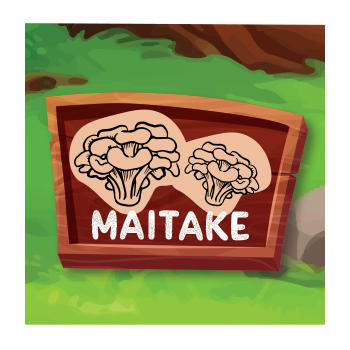
It also contains a unique bioactive compound—SX-fraction—that scientists have discovered has a profound effect on the cluster of symptoms known as metabolic syndrome, which includes excess weight, high blood sugar and insulin, and elevated cholesterol and triglyceride levels. An animal model of type-2 diabetes found that an extract from the fruiting body of maitake significantly decreased weight, fasting blood glucose, insulin, triglycerides, and cholesterol, while increasing the activity of superoxide dismutase (SOD) and glutathione, powerful antioxidants produced in the body.28 Other research investigating the effects of whole powdered maitake, as well as both alcohol and water extracts, has found similar results, with reductions in blood glucose and insulin levels, improvement in insulin sensitivity, and reduced blood pressure.29 30 31 32
Whatever your health goal—from maintaining a healthy, youthful brain to balancing blood sugar, modulating inflammation, and everything in between—there’s a mushroom supplement ready to help you tackle it. Discover your true health potential with these six must-have mushrooms and make room for a healthy, new you.



Sign-up for {N}power to get exclusive discounts, newsletters, members-only features, and more!